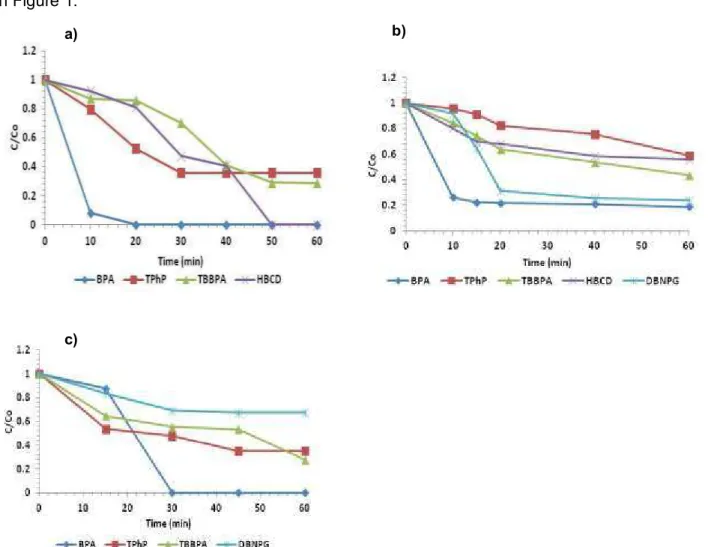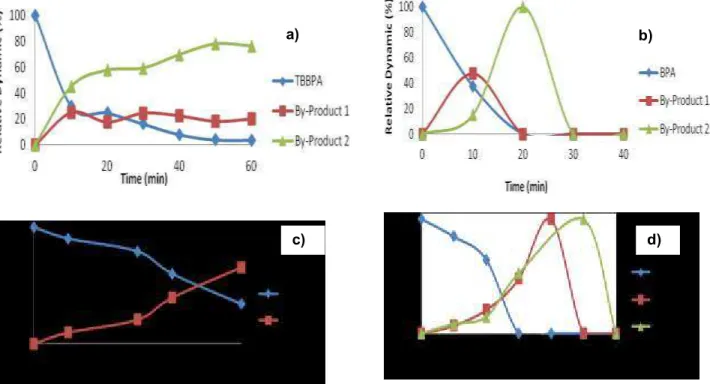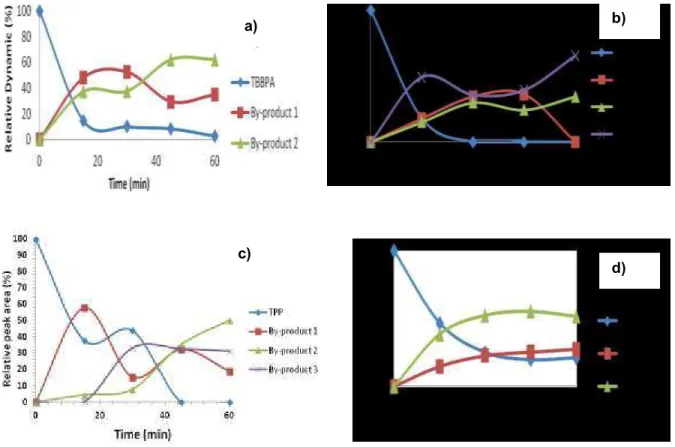IOA WORLD CONGRESS & EXHIBITION, JUNE 28 to JULY 3, BARCELONA, SPAIN, 2015 1/10
PHOTOLYSIS, OZONATION AND CHLORINATION OF FLAME RETARDANTS IN WATER
TREATMENT
Ricardo Salgado1,2, Cátia Chanfana1, Susana Martins1, Dina Galhanas1, Lisete Epifâneo,1,3 and João Paulo
Noronha1,2
1
ESTS-IPS-Escola Superior de Tecnologia de Setúbal do Instituto Politécnico de Setúbal, Rua Vale de Chaves, Campus do IPS, Estefanilha, 2910-761 Setúbal, Portugal, Ph: +351 265 790 000; Fax: +351 265 721 869;
E-mail: ricardo.salgado@estsetubal.ips.pt 2
REQUIMTE/CQFB, Chemistry Department, FCT, Universidade Nova de Lisboa, 2829-516 Caparica, Portugal.
3
SIMARSUL-Sistema Integrado Multimunicipal de Águas Residuais da Península de Setúbal, S.A. Av. Luísa Todi, 300-3º, 2900-452 Setúbal, Portugal
Key words: Flame retardants; Photolysis; Ozonation; Chlorination; Water treatment.
Abstract
IOA WORLD CONGRESS & EXHIBITION, JUNE 28 to JULY 3, BARCELONA, SPAIN, 2015 2/10 1. Introduction
Flame retardants are chemicals that delay the ignition of an inflammable polymer material, and prevent the expansion of combustion. They are widely used to make polymer organic materials such as plastic, rubber, wood and fiber flame resistant, making a great contribution to preventing hu man and economic loss by fire [1]. Wastes from plastic, textiles, etc. with brominated FRs are incinerated, followed by final disposal of the incineration residue in landfill [2, 3]. When the rainwater penetrates in landfill layers, the water in contact with the plastic wastes containing brominated FRs, relatively hydrophilic such as TBBPA can dissolve this organic compounds and leachate them to the water bodies. The dissolved organic matter (DOM) in the leachate can also interact with hydrophobic compounds such as PBDEs in the plastics and enhance the leachability of brominated FRs [4-5].
In urban areas effluents from wastewater treatment plants (WWTP) are the main source of anthropogenic chemicals discharged into the aquatic environment. These compound present low removal rates in WWTPs and become of emerging concern since analytical equipment to detect substances below 1 g/L was engineered and made trace pollutants observable. New and emerging compounds are continuously discovered in the environment such as FR. Many studies report the presence of FR in wastewater [4, 5], water [6, 7] and sediments [8, 9]. Under normal environmental conditions, several of these chemicals are persistent and they can contaminate surface and groundwater bodies. Some fraction of these halogenated organic compounds can be biodegradable in activated sludge processes but an important fraction is not completely removed and can occur in the disinfection process in the WWTP. The presence of these compounds in the disinfection or in oxidation processes in the water and wastewater treatment systems by the use of ozonation [10-12], UV radiation [12] or chlorination [13] can affect the transformation of these compounds. Some of these FRs can cause environmental problems due to their persistence in surface waters and constant input via sewage effluents as a result of their insufficient elimination by conventional WW treatment with activated sludge. Risks to human health and to the aquatic wildlife display a need to reduce the emission of chemicals into surface waters [14-16]. This study addresses to observe the degradation kinetics of the FR using ozone, photolysis and chlorine in water. The determination of the kinetic degradation rates and the by-product formation were also studied in this work during the ozonation, photolysis and chlorination of the target FR in water. A comparison between the impacts of these 3 different oxidation technologies in the removal can contribute to better understand which technology can be most effective in the degradation of the FR and in the generation of a minor number of by -products with potential impact in the environment.
2. Materials and methods
2.1 Ozonation experiments
800 ml of deionized water with a concentration of 1 ppm of each compound was used in cylinder reactor with 1L capacity closed and well isolated. The ozone produced by Ozonizer (Hailea, HLO 820A, 60W, 15 L/min) was injects continuously in order to obtain a specific ozone dissolved concentration (1.5 mg O3 L-1). Samples of the reactor were taken every 10 minutes over one hour and
IOA WORLD CONGRESS & EXHIBITION, JUNE 28 to JULY 3, BARCELONA, SPAIN, 2015 3/10 2.2 Photolysis in MP/UV lamp experiments
The experiments were carried out in a glass cylinder reactor with a maximum volume of 700 mL, using an Hg lamp medium pressure (MP/UV), Heraeus Noblelight model TQ 150 (nominal power 150 W) which emits radiation between 200 and 600nm. The cooling jacket used was made of quartz, and pure water with negligible light adsorption in the wavelength range of emitted radiation was used as filter solution and maintained at a temperature of 25ºC. The experiments with the FRs were performed with an initial concentration of 1ppm. Samples were taken every 10 minutes and immediately analyzed by HPLC-UV.
2.3 Chlorination experiments
The chlorination experiments were carried out in 50 ml of deionized water with a concentration of 1 ppm of each the compound. Sodium hypochlorite was added to the reactor in order to achieve 0.3 ppm of free residual chlorine in water and stirred with magnetic stirrer. pH was not adjusted during the experiments. Reactor samples were collected at 0, 10, 15, 20, 40, 60 min, and immediately analyzed by HPLC-UV.
2.4 Analytical procedures
For the detection and analysis of the compounds, it was used a HPLC equipment (Waters) with DAD detector (photodiode array detector, Waters 996). A chromatography column LiChroCART 250-4 HPLC Cartridge-Purospher Star RP-18 endcapped (5 µm) with pre-column LiChroCART 4-4, Purospher Star RP 18-e (5 µm) and an autosampler (Waters 717 plus) coupled pump and controller (Waters 600) with degasser (X-Act-4 channels, Jour Research). The mobile phase used for this method was methanol:water (70:30), acidified to pH 3 with formic acid, vacuum filtered after preparation through a membrane filter nylon 0.45 µm and degassed ultrasonically for 30 minutes before use. The injected volume of the standards and range solutions was 20 L. For the compounds DBNPG and HBCD was at 220 nm, at 260 nm was for TPP, 275 nm for BPA and for TBBPA was 285nm.
3. Results and discussion 3.1 Degradation of FR
The degradability of the FRs compounds was determined by analysis of samples taken during the degradation experiment with each compound. For the ozonation experiments, the reactor operated during one hour, with a continuous injection of an ozone dose in the range 1.19-1.76 mg O3/L. The
IOA WORLD CONGRESS & EXHIBITION, JUNE 28 to JULY 3, BARCELONA, SPAIN, 2015 4/10
this study. Photolysis and chlorination experiments operate during one hour and the results are plotted in Figure 1.
Figure 1. Degradation of the FR compounds in a) photolysis, b) chlorination, c) ozonation experiments
Only BPA observed completely removal after 17 min when the compound was exposed to the MP/UV lamp. All the other compounds observed partially removal after 60 min of being exposed to the MP/UV lamp. 86%, 74% and 64% removal was observed for TBBPA, HBCD, and TPP, respectively.
In the ozonation, only the BPA presented a total degradation after 30 minutes of contact time. All the other compounds did not attained total degradation in 60 minutes. 34%, 65% and 82 % removal was observed for DBNPG, TPP and TBBPA, respectively.
In the chlorination experiments, it was observed BPA degradation with a maximum removal rate achieved after 10 min and then it still constant until the final of the experiment. The final removal observed was 74% after adding a dose of sodium hypochlorite that keeps the residual chlorine concentration of 0.3 ppm. It would be certainly necessary to increase the range of residual chlorine
a)
c)
IOA WORLD CONGRESS & EXHIBITION, JUNE 28 to JULY 3, BARCELONA, SPAIN, 2015 5/10
existing in the water to get a completely removal of this compound in the water. Many studies reported that under chlorination and ozonation oxidation techniques, one of the by-products may be formed bromate (BRO3-) or other bromide compounds, which could have a potential carcinogenic effect on the
living organisms [17]. The chlorination and ozonation when applied to the degradation of brominated FR can produce this carcinogenic compound that needs to be avoided and controlled. This justifies that the oxidation technologies should be always combined with other technologies, such as e.g. adsorption in activated carbon.
3.2 Kinetic degradation constant rates
After the results of the experiments (ozonation and photolysis) for each compound were selected compounds wherein noted a higher degradation, to determinate the kinetic parameters. The photolysis of the studied FR in pure water followed a order kinetics, and the time-based pseudo-first-order rate constants (k) were determined according to equation 1 [18-19]:
Where C is the concentration of the compounds and C0 is the initial concentration of the compounds.
Table 1 show the time-base constants rate, k (min-1) of the FR degradation during the ozonation, photolysis and chlorination experiments.
Table 1. Time-base constant kinetics (k) for the ozonation, photolysis and chlorination (min-1)
Experiment BPA TBBPA DBNPG TPP HBCD
Ozonation 0.009 0.017 0.004 0.011 nd
Photolysis 0.591 0.018 nd 0.015 0.022
Chlorination 0.050 0.012 0.024 0.009 0.007
nd – not determined
The constant (k) determines the removal rate of a compound when subject to a specific reaction (e.g with ozone, UV radiation or chlorine). MP/UV photolysis and ozonation of TPP and TBBPA had comparable time-based degradation rate constants and one order of magnitude higher than DBNPG. Both compounds were removed below detection levels in only a few minutes than they decrease the concentration very slowly (Figure 1) whereas BPA took completely removed over 17 minutes of irradiation and 30 minutes in ozonation and get the maximum removal after 10 min in the chlorination. These parameters reflect the probability of a compound to be degraded at the wavelength range used when the MP/UV lamp is used, and in this study indicated a higher degradation potential for BPA followed by TBBPA and then TPP. In this case, it can be reported that the compound TBBPA is more removed, since it contains a higher removal rate for both treatments, followed compound TPP and DBNPG.
IOA WORLD CONGRESS & EXHIBITION, JUNE 28 to JULY 3, BARCELONA, SPAIN, 2015 6/10 3.3 Degradation and by-product formation
MP/UV irradiation, ozonation and chlorination of the target compounds result in the formation of new chromatographic peaks corresponding to transformation products generated during the oxidation processes. Three peaks were identified from BPA, TBBPA and TPP under photolysis and ozonation, four peaks from HBCD, and two from DBNPG.
Most of the products generated in the MP/UV radiation are similar to the ones generates in the ozonation. Only HBCD presents differences between the products generated in MP/UV and ozonation. In this case, 4 products were formed during the ozonation and only one in the photolysis. In similar studies, other authors also detect and report the presence of transformation products using MP photolysis, ozonation and chlorination.
The dynamics of the MP/UV phototransformation, ozonation and chlorination products suggests possible mechanisms of conversion of the FR. The proposed mechanisms assumed that the favourable reactions in the conditions used in this study were: hydroxylation in parts of the molecule that were most susceptible to attack by
•
OH radicals; oxidation with O2, which was present in thereaction medium since air bubbling was used for homogenisation; and the loss of some specific groups such as Cl, Br, amides, etc.
Figure 2 represents the degradation of the BPA and the formation of the respective by-products in the chlorination experiments. For the compound BPA were detected three by-products formed.
Figure 2. Degradation of BPA and by-product formation in chlorination
IOA WORLD CONGRESS & EXHIBITION, JUNE 28 to JULY 3, BARCELONA, SPAIN, 2015 7/10
more polar than the target compounds. The increase of the polar by-products can be justified the oxidation that promotes the introduction of oxygen or hydroxyl groups.
Figure 3 shows the detected by-products of the TBBPA, BPA, HBCD and TPP compounds analyzed in photolysis.
Figure 3. Degradation of compounds a) TBBPA; b) BPA; c) HBCD and d) TPP in photolysis
The compound HBCD, as a direct relation between by-product and the compound itself, since that the degradation of the compound occurs, the by-product concentration increases proportionally. In the TBBPA can be observed the formation of two by-products, however, these by-products have different characteristics because they increase the formation of both by-products. The by-product 2 presents a high absorption when detected in HPLC-UV detector than the product 1. In the degradation of the BPA, two by-products were formed. The by-product 1 immediately formed when the BPA is irradiated with the MP/UV lamp and then this product became converted in the by-product 2, assume then that the reaction continuously undergoing. The higher relative peak area of the compound 2 when compared with the compound 1 is related with the high absorbance of the high number of hydroxyl or oxygen groups or other groups present in the molecule and it does not mean a higher concentration of the compound. The by-products and also the BPA are completely oxidized after 40 min of irradiation in MP/UV lamp. In the experiment with TPP, two products were formed; however, they were by-products possibly with different characteristics because, during the degradation of TPP, the increasing concentration in both of them can be observed.
a) b)
IOA WORLD CONGRESS & EXHIBITION, JUNE 28 to JULY 3, BARCELONA, SPAIN, 2015 8/10
Since both compounds TPP and BPA, and respectively by-products were completely degraded after one hour the formation of by-products were not an environmentally concern, so it could not have a significant environmental impact. Future toxicity studies should be done in order to confirm the final toxicity of the final mixture of compounds. Yang also detected by-products of photolysis of FR resulting from the de-halogenation of the molecule [12].
The by-products of the degradation of BPA, TBBPA, TPP and DBNPG in the ozonation are plotted in Figure 4
Figure 4. Degradation of compounds a) TBBPA; b) BPA; c) TPP and d) DBNPG in ozonation
The degradation of the target compound is related with the formation of the new products as discussed previously for the chlorination and the photolysis. The BPA degrades completely, and consequently an increase concentration of by-products was observed. The formation of two types of by-products was observed during the TBBPA degradation. The second by-product was the most persistent, increasing its concentration with the decrease of by-product 1. For compound DBNPG can again be observed the formation of two by-products, however, they were by-products possibly with different characteristics because they increase its concentration without being greatly affected by the
a) b)
c)
IOA WORLD CONGRESS & EXHIBITION, JUNE 28 to JULY 3, BARCELONA, SPAIN, 2015 9/10
treatment. Three by-products were formed during the degradation of TPP, where the by-product 1 and the by-product 3 can be correlated and became part of the degradation mechanism of these compounds, since the formation of degradation depends on the other, assuming that the reaction was undergoing continuously meanwhile the TPP exists and reacts with the ozone. The second by-product seems to be independent of the other by-products.
The by-products formed in chlorination, ozonation and photolysis had similar proprieties because of the chromatographic retention time and optical absorption proprieties were similar and they were all more polar compound than the target compounds which mean that they were more water soluble than the original compounds and consequently tend to be more biodegradable in the environment
4. Conclusions
The chlorination with 0.3 ppm of free residual chlorine of the FR in water was, in general, less efficient for the removal of this brominated organic compounds when compared with the use of ozone or MP/UV lamps. Completley removal of BPA was achieved with MP/UV radiation and even with a small dose of ozone apllied. All this oxidation techniques produce by-products and additional toxicity experiments of the final mixtures of the residual target compound and the by-products formed.
References
[1] Decong H., Xiaozhong H., Li, J., Wang, P., Guo, S., (2012), Determinations of HBCD isomers in plastic products from China by LC-MS/MS, J. Liq Chrom. & Related Technol.,35, 558-572.
[2] Söderström, G., Marklund, S., (2002). PBCDD and PBCDF from Incineration of Waste-Containing Brominated Flame Retardants, Environ. Chem., 36, 1959-1964.
[3] Schlummer, M., Mäurer, A., Eldik, R.V., Quicker, P., Fischer, W., Faulstich, M., (2007). Post Combustion Syntheses of PCDD/F and PBDD/F from Halogen-Rich Fuel is Suppressed by a Pebble Heater Technology”,
Pebble Heater Technol., 14, 414-420.
[4] Osako, M., Kim, Y., Sakai, S., (2004), Leaching of brominated flame retardants in leachate from landfills in Japan, Chemosphere, 57, 1571-1579.
[5] Eggen, T., Moeder, M., Arukwe, A., (2010), Municipal landfill leachates: A significant source for new and emerging pollutants, Sci. of the Total Environ., 408, 5147-5157.
[6] Rodriguez-Mozaz, S., Alda, M.J.L., Barceló, D.. (2004), Monitoring of estrogens, pesticides and BPA in natural waters and drinking water treatment plants by solid-phase extraction-liquid chromatography-mass spectrometry, J. of Chrom. A, 1045, 85-92.
[7] Vives, I., Canuti E., Castro-Jiménez, J., Christoph, E.H, Eisenreich, S.J., Hanke, G., Huber, T., Mariani, G., Mueller, A., Skejo, H., Umlauf G., Wollgast, J., (2007). Occurrence of polychlorinated dibenzo-p-dioxins and dibenzofurans (PCDD/Fs), polychlorinated biphenyls (PCBs) and polybrominated diphenyl ethers (PBDEs) in Lake Maggiore (Italy and Switzerland), J. environ monitor, 9(6), 589-98.
[8] Lacorte, S., Guillamon, M., Martinez, E., Viana, P., (2003).Occurrence and specific congener profile of 40 polybrominated diphenyl ethers in river and coastal sediments from Portugal, Environ. Sci Technol, 37(5), 892-898.
[9] Zegers, B.N.; Lewis, W.E.; Booij, K.; Smittenberg, R.H.; Boer, W.; De Boer, J.; Boon, J.P., (2003).Levels of polybrominated diphenyl ether flame retardants in sediment cores from Western Europe. Environ Sci Technol, 37, 3803-3807.
IOA WORLD CONGRESS & EXHIBITION, JUNE 28 to JULY 3, BARCELONA, SPAIN, 2015 10/10
[11] Deborde M., Rabouan S., Mazellier P., Duguet J., Legube B., (2008), Oxidation of bisphenol A by ozone in aqueous solution, Water Research, 42, 4299-4308.
[12] Yang, S., Chun-Kang W., (2008), Photolytic degradation of polybromodiphenyl ethers under UV-lamp and solar irradiations, J. Hazard. Mat., 165, 34-38.
[13] Sun, Y., Wu, Q., Hu, H., Tian, J., (2009). Effect of bromide on the formation of disinfection by-products during wastewater chlorination, Wat res, 43, 2391-2398.
[14] Villanger, G.D., Lydersen, C., Kovacs, K.M., Lie, E., Skaare, J.U., Jenssen, B.M., (2011). Disruptive effects of persistent organohalogen contaminants on thyroid function in white whales (Delphinapterus leucas) from Svalbard, Sci. of the Total Environ., 409, 2511-2524.
[15] Letcher, R.J.; Gebbink, W.A.; Sonne, C.; Dietz, R.; McKinney, M.A.; Born, E.W., (2009) Bioaccumulation and biotransformation of brominated and chlorinated contaminants and their Metabolites in ringed seals (Pusa hispida) and polar bears (Ursus maritimus) from East Greenland. Environ. Internat. 35, 1118-1124.
[16] Magdeburg, A., Stalter, D., Oehlmann, J. (2012), Whole effluent toxicity assessment at a wastewater treatment plant upgraded with a full-scale post-ozonation using aquatic key species, Chemosphere, 88, 1008-1014.
[17] Sun, Y., Wu, Q., Hu, H., Tian, J., (2009). Effect of bromide on the formation of disinfection by-products during wastewater chlorination, Wat Res, 43, 2391–2398.
[18] Lopez, A., Anna, B., Giuseppe, M., John, K., (2003), Kinetic investigation on UV and UV/H2O2 degradations of pharmaceutical intermediates in aqueous solution, J. Photochem. Photobiol., 156, 121-126.
[19] Kim, I., Yamashita, N., Tanaka, H., (2009), Performance of UV and UV/H2O2 processes for the removal of pharmaceuticals detected in secondary effluent of a sewage treatment plant in Japan, J. Hazard. Mat., 166, 1134-1140.
Acknowledgements




